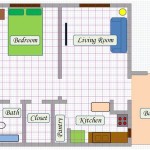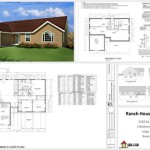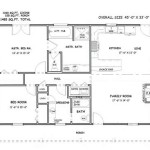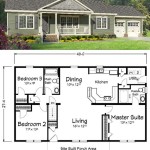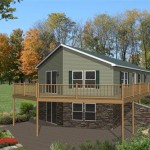4 Bedroom House Plans: The Appeal of One-Level Living
One-level living, encapsulated in 4 bedroom house plans, offers a compelling combination of accessibility, convenience, and style. This architectural approach is increasingly popular amongst a diverse range of homeowners, from young families to retirees, seeking a practical and comfortable living environment. The inherent advantages of a single-story home extend beyond mere convenience, impacting lifestyle, maintenance, and long-term value.
The design of a 4 bedroom house plan on a single level requires careful consideration of space management, efficient circulation, and a strategic approach to incorporating natural light. Unlike multi-story homes where bedrooms are often relegated to upper levels, a one-level design necessitates a cohesive layout that integrates living spaces, bedrooms, and service areas seamlessly. This article explores the key benefits, design considerations, and diverse styles available within the realm of 4 bedroom one-level house plans.
Accessibility and Universal Design Principles
The most significant advantage of a single-story residence is its inherent accessibility. Eliminating stairs removes a major obstacle for individuals with mobility challenges, including young children, those recovering from injuries, and elderly residents. This characteristic aligns directly with the principles of universal design, which aims to create environments that are usable by all people, to the greatest extent possible, without the need for adaptation or specialized design.
Features such as wide doorways, roll-in showers, and grab bars can be easily incorporated into a one-level home to further enhance accessibility. Ramps can replace steps at entry points, and lever handles are more user-friendly than doorknobs for individuals with limited dexterity. The absence of stairs also minimizes the risk of falls, a significant concern for older adults.
Beyond physical limitations, a one-story layout fosters a greater sense of connection within the home. Family members can easily move between rooms, promoting interaction and communication. This is particularly beneficial for families with young children who require supervision, as parents can maintain visual contact while attending to other tasks.
Furthermore, accessibility extends to the external environment. Garden maintenance, outdoor entertaining, and accessing exterior storage spaces become significantly easier without the need to navigate stairs or inclines. This feature is particularly appealing for individuals who enjoy gardening or outdoor activities but may face physical limitations.
Efficiency and Cost Considerations
While the initial cost of building a one-level 4 bedroom house may be comparable to a multi-story home of similar square footage, long-term cost benefits can accrue through various efficiencies. Heating and cooling costs are often lower in single-story homes due to the absence of temperature stratification that occurs in multi-level dwellings. Warm air rises, leading to temperature discrepancies between floors, which can result in increased energy consumption.
Maintenance costs are also generally lower for one-level homes. Roof repairs, gutter cleaning, and exterior painting are less complex and less expensive to perform on a single-story structure. Window cleaning is also simplified, as all windows are easily accessible from ground level.
Construction costs can be optimized through strategic design choices. Simplified rooflines, efficient floor plans, and the use of sustainable building materials can all contribute to cost savings. Passive solar design, which utilizes the sun's energy for heating and cooling, can further reduce energy consumption and lower utility bills.
Landscaping costs may be slightly higher for a one-level home, as a larger footprint necessitates a larger yard. However, this can be offset by carefully planning the landscape to minimize maintenance requirements. Drought-tolerant plants, efficient irrigation systems, and strategically placed trees can reduce water consumption and labor costs.
The resale value of a one-level home can be a significant advantage, particularly in areas with a large population of retirees or individuals with mobility challenges. The demand for accessible housing is steadily increasing, making one-level homes a desirable and valuable asset.
Design Styles and Layout Options
One-level 4 bedroom house plans are available in a wide variety of architectural styles, ranging from traditional to contemporary. Ranch-style homes, with their low-pitched roofs, horizontal emphasis, and attached garages, are a classic choice for one-level living. Craftsman-style homes, characterized by their intricate details, exposed rafters, and covered porches, also lend themselves well to a single-story design.
Contemporary and modern designs often feature open floor plans, clean lines, and large windows that maximize natural light. These styles can be adapted to a one-level layout, creating a spacious and airy living environment. Incorporating elements such as vaulted ceilings and clerestory windows can further enhance the sense of spaciousness.
Layout options for a 4 bedroom one-level house are diverse and can be tailored to individual needs and preferences. A split-bedroom layout, which places the master suite on one side of the house and the remaining bedrooms on the other, provides increased privacy. An open-concept living area, combining the kitchen, dining room, and living room, creates a central gathering space for family and friends.
Consideration should be given to the placement of bedrooms in relation to living areas. While proximity can be convenient for monitoring young children, it can also lead to noise disturbances. Proper insulation and soundproofing can mitigate this issue. The orientation of the house on the lot is also crucial, as it affects the amount of sunlight entering the home and the overall energy efficiency.
Outdoor living spaces, such as patios, decks, and porches, are an integral part of many one-level house plans. These areas provide additional living space and can be seamlessly integrated with the interior through sliding glass doors or French doors. Outdoor kitchens, fire pits, and comfortable seating areas can transform a backyard into an inviting and functional extension of the home.
The integration of smart home technology can further enhance the convenience and efficiency of a one-level home. Automated lighting, climate control, and security systems can be easily controlled from a smartphone or tablet. Voice-activated assistants can also be used to manage various aspects of the home, such as adjusting the thermostat, playing music, and controlling appliances.
Flex spaces are also a valuable addition to a 4 bedroom one-level house plan. These rooms can be used as home offices, playrooms, guest rooms, or hobby areas. Their versatility allows homeowners to adapt the space to their changing needs over time. A bonus room above the garage or a finished basement can provide additional living space if needed.
In summary, the design of a 4 bedroom one-level house requires careful planning and attention to detail. However, the numerous benefits, including accessibility, efficiency, and design flexibility, make it an attractive option for a wide range of homeowners. By considering the specific needs and preferences of the occupants, a one-level home can be transformed into a comfortable, functional, and stylish living environment.

Pin Page

Pin Page

One Story 4 Bedroom Farm House Style Plan 8817

Modern Farmhouse Plan 3 150 Square Feet 4 5 Bedrooms Bathrooms 8687 00002

4 Bedroom House Plan Examples

2400 Craftsman House Floor Plans Square Foot 4 Bedroom 1 Story

One Story 4 Bed Modern Farmhouse Plan With Home Office 2607 Sq Ft 51841hz Architectural Designs House Plans

House Plan 52028 One Story Style With 2944 Sq Ft 4 Bed Bath

Four Bedroom One Story House Plan 82055ka Architectural Designs Plans

4 Bedroom House Single Y Plans Montgomery Homes 25 Display In Nsw


